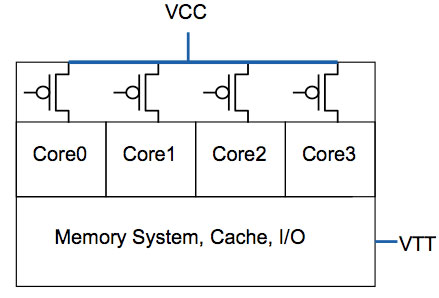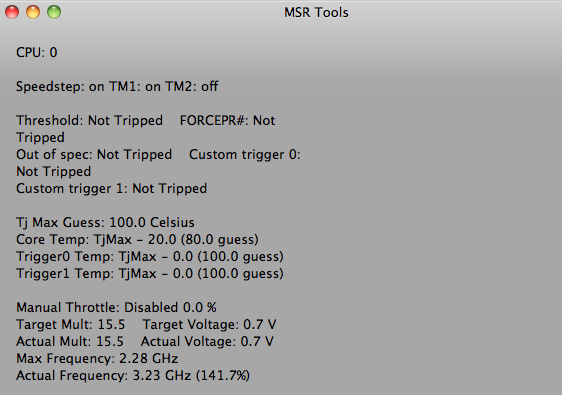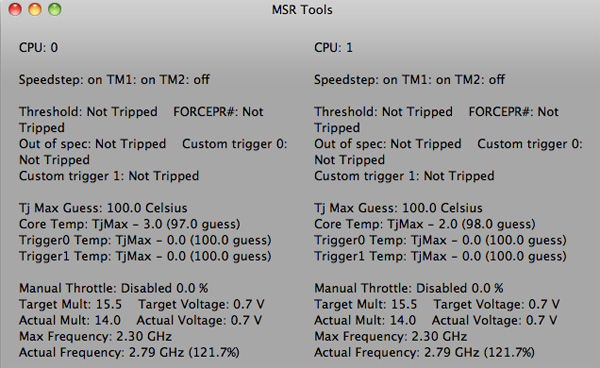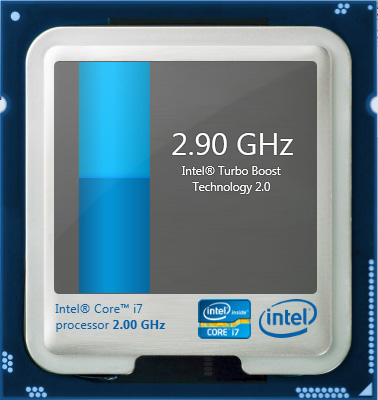The MacBook Pro Review (13 & 15-inch): 2011 Brings Sandy Bridge
by Anand Lal Shimpi, Brian Klug & Vivek Gowri on March 10, 2011 4:17 PM EST- Posted in
- Laptops
- Mac
- Apple
- Intel
- MacBook Pro
- Sandy Bridge
Turbo and the 15-inch MacBook Pro
The 15 and 13 are different enough that I'll address the two separately. Both are huge steps forward compared to their predecessors, but for completely different reasons. Let's start with the 15.
Starting with Sandy Bridge, all 15 and 17-inch MacBook Pros now feature quad-core CPUs. This is a huge deal. Unlike other notebook OEMs, Apple tends to be a one-size-fits-all sort of company. Sure you get choice of screen size, but the options dwindle significantly once you've decided how big of a notebook you want. For the 15 and 17-inch MBPs, all you get are quad-core CPUs. Don't need four cores? Doesn't matter, you're getting them anyway
| Evolution of the 15-inch MacBook Pro | Early 2011 | Mid 2010 | Late 2009 |
| CPU | Intel Core i7 2.0GHz (QC) | Intel Core i5 2.40GHz (DC) | Intel Core 2 Duo 2.53GHz (DC) |
| Memory | 4GB DDR3-1333 | 4GB DDR3-1066 | 4GB DDR3-1066 |
| HDD | 500GB 5400RPM | 320GB 5400RPM | 250GB 5400RPM |
| Video | Intel HD 3000 + AMD Radeon HD 6490M (256MB) |
Intel HD Graphics + NVIDIA GeForce GT 330M (256MB) |
NVIDIA GeForce 9400M (integrated) |
| Optical Drive | 8X Slot Load DL DVD +/-R | 8X Slot Load DL DVD +/-R | 8X Slot Load DL DVD +/-R |
| Screen Resolution | 1440 x 900 | 1440 x 900 | 1440 x 900 |
| USB | 2 | 2 | 2 |
| SD Card Reader | Yes | Yes | Yes |
| FireWire 800 | 1 | 1 | 1 |
| ExpressCard/34 | No | No | No |
| Battery | 77.5Wh | 77.5Wh | 73Wh |
| Dimensions (W x D x H) | 14.35" x 9.82" x 0.95" | 14.35" x 9.82" x 0.95" | 14.35" x 9.82" x 0.95" |
| Weight | 5.6 lbs | 5.6 lbs | 5.5 lbs |
| Price | $1799 | $1799 | $1699 |
Apple was able to rationalize this decision because of one feature: Intel Turbo Boost.
In the ramp to 90nm Intel realized that it was expending a great deal of power in the form of leakage current. You may have heard transistors referred to as digital switches. Turn them on and current flows, turn them off and current stops flowing. The reality is that even when transistors are off, some current may still flow. This is known as leakage current and it becomes a bigger problem the smaller your transistors become.

With Nehalem Intel introduced a new type of transistor into its architecture: the power gate transistor. Put one of these babies in front of the source voltage to a large group of transistors and at the flip of a, err, switch you can completely shut off power to those transistors. No current going to the transistors means effectively no leakage current.
Prior to Intel's use of power gating, we had the next best thing: clock gating. Instead of cutting power to a group of transistors, you'd cut the clock signal. With no clock signal, any clocked transistors would effectively be idle. Any blocks that are clock gated consume no active power, however it doesn't address the issue of leakage power. So while clock gating got you some thermal headroom, it became less efficient as we moved to smaller and smaller transistors.

All four cores in this case have the same source voltage, but can be turned off individually thanks to the power gate above the core
Power gating gave Intel one very important feature: the ability to truly shut off a core when not in use. Prior to power gating Intel, like any other microprocessor company, had to make tradeoffs in choosing core count vs. clock speed. The maximum power consumption/thermal output is effectively a fixed value, physics has something to do with that. If you want four cores in the same thermal envelope as two cores, you have to clock them lower. In the pre-Nehalem days you had to choose between two faster cores or four slower cores, there was no option for people who needed both.
Now, with the ability to mostly turn off idle cores, you can get around that problem. A fully loaded four core CPU will still run at a lower clock than a dual core version, however with power gating if you are only using two cores then you have the thermal headroom to ramp up the clock speed of the two active cores (since the idle ones are effectively off).

Get a little more clever and you can do this power gate and clock up dance for more configurations. Only using one core? Power gate three and run the single active core at a really really high speed. All of this is done by a very complex piece of circuitry on the microprocessor die. Intel introduced it in Nehalem and called it the Power Control Unit (this is why engineers aren't good marketers but great truth tellers). The PCU in Nehalem was about a million transistors, around the complexity of the old Intel 486, and all it did was look at processor load, temperature, power consumption, active cores and clock speed. Based on all of these inputs it would determine what to turn off and what clock speed to run the entire chip at.
Another interesting side effect of the PCU is that if you're using all cores but they're not using the most power hungry parts of their circuitry (e.g. not running a bunch of floating point workloads) the PCU could keep all four active but run them at a slightly higher frequency.
| Single Core | Dual Core | Quad Core | |
| TDP |
 |
 |
 |
| Tradeoff |
 |
 |
 |
The PCU actually works very quickly. Let's say you're running an application that only for a very brief period is only using a single core. That's more than enough time for the PMU to turn off all unused cores, turbo up the single core and complete the task quicker.
Intel calls this dynamic frequency scaling Turbo Boost (ah this is where the marketing folks took over). The reason I went through this lengthy explanation of Turbo is because it allowed Apple to equip the 15-inch Macbook Pro with only quad-core options and not worry about it being slower than the dual-core 13-inch offering, despite having a lower base clock speed (2.0GHz for the 15 vs. 2.3GHz for the 13).

13-inch MacBook Pro (left), 15-inch MacBook Pro with optional high res/anti-glare display (right)
Apple offers three CPU options in the 15-inch MacBook Pro: a 2.0GHz, 2.2GHz or 2.3GHz quad-core Core i7. These actually correspond to the Core i7-2635QM, 2720QM and 2820QM. The main differences are in the table below:
| Apple 15-inch 2011 MacBook Pro CPU Comparison | |||||
| 2.0GHz quad-core | 2.2GHz quad-core | 2.3GHz quad-core | |||
| Intel Model | Core i7-2635QM | Intel Core i7-2720QM | Intel Core i7-2820QM | ||
| Base Clock Speed | 2.0GHz | 2.2GHz | 2.3GHz | ||
| Max SC Turbo | 2.9GHz | 3.3GHz | 3.4GHz | ||
| Max DC Turbo | 2.8GHz | 3.2GHz | 3.3GHz | ||
| Max QC Turbo | 2.6GHz | 3.0GHz | 3.1GHz | ||
| L3 Cache | 6MB | 6MB | 8MB | ||
| AES-NI | No | Yes | Yes | ||
| VT-x | Yes | Yes | Yes | ||
| VT-d | No | Yes | Yes | ||
| TDP | 45W | 45W | 45W | ||
The most annoying part of all of this is that the base 2635 doesn't support Intel's AES-NI. Apple still doesn't use AES-NI anywhere in its OS it seems so until Lion rolls around I guess this won't be an issue. Shame on Apple for not supporting AES-NI and shame on Intel for using it as a differentiating feature between parts. The AES instructions, introduced in Westmere, are particularly useful in accelerating full disk encryption as we've seen under Windows 7.
Note that all of these chips carry a 45W TDP, that's up from 35W in the 13-inch and last year's 15-inch model. We're talking about nearly a billion transistors fabbed on Intel's 32nm process—that's almost double the transistor count of the Arrandale chips found in last year's MacBook Pro. These things are going to consume more power.
Despite the fairly low base clock speeds, these CPUs can turbo up to pretty high values depending on how many cores are active. The base 2.0GHz quad-core is only good for up to 2.9GHz on paper, while the 2720QM and 2820QM can hit 3.3GHz and 3.4GHz, respectively.
Given Apple's history of throttling CPUs and not telling anyone I was extra paranoid in finding out if any funny business was going on with the new MacBook Pros. Unfortunately there are very few ways of measuring turbo frequency under OS X. Ryan Smith pointed me in the direction of MSR Tools which, although not perfect, does give you an indication of what clock speed your CPU is running at.

Max single core turbo on the 2.3GHz quad-core
With only a single thread active the 2.3GHz quad-core seemed to peak at ~3.1—3.3GHz. This is slightly lower than what I saw under Windows (3.3—3.4GHz pretty consistently running Cinebench R10 1CPU test). Apple does do power management differently under OS X, however I'm not entirely sure that the MSR Tools application is reporting frequency as quickly as Intel's utilities under Windows 7.

Max QC turbo on the 2.3GHz quad-core
With all cores active (once again, Cinebench R10 XCPU) the max I saw on the 2.3 was 2.8GHz. Under Windows running the same test I saw similar results at 2.9GHz.

Max QC turbo on the 2.3GHz quad-core under Windows 7
I'm pretty confident that Apple isn't doing anything dramatic with clock speeds on these new MacBook Pros. Mac OS X may be more aggressive with power management than Windows, but max clock speed remains untouched.
| Mac OS X 10.6.6 vs. Windows 7 Performance | ||||
| 15-inch 2011 MBP, 2.0GHz quad-core | Single-Threaded | Multi-Threaded | ||
| Mac OS X 10.6.6 | 4060 | 15249 | ||
| Windows 7 x64 | 4530 | 16931 | ||
Note that even though the operating frequencies are similar under OS X and Windows 7, Cinebench performance is still higher under Windows 7. It looks like there's still some software optimization that needs to be done under OS X.











198 Comments
View All Comments
jb510 - Friday, March 11, 2011 - link
It would seem to me their is one currently shipping Thunderbolt periphral... A 2011 MBP in target disk mode. Maybe you could drop an SSD in one and do some preliminary testing?jb510 - Friday, March 11, 2011 - link
damn... wish i could edit that comment originally typed on my iphone... but their doesn't appear to be any way... (misspelling repeated for comedic effect)deadshort - Friday, March 11, 2011 - link
Thanks for the genuinely informative review. Running both low-load and high-load battery tests is especially helpful to developers, etc.One question. You chose the 2.3Ghz/8MB cache system. Was that just 'cuz you swing that way, or do you expect significant performance benefits for some workload you care about? For these machines is it a 10% price goldplate, or a reasonable increment to keep these CPUs fed? I am seriously interested....
Brian Klug - Friday, March 11, 2011 - link
I can speak for myself at least, but part of the reason for the 2.3/8 MB system choice was that it's the only preconfigured (Apple Store available) configuration that comes with the anti-glare display.Essentially, if you're a customer walking into the apple store and don't want the glossy/glare display, you're immediately forced into buying the highest-specced (and most expensive) MacBook Pro. It's frustrating because the only way to get lower specced systems is BTO online.
Obviously we got these systems on launch date to immediately start working, and that was the reason for the 2.3 choice.
-Brian
synaesthetic - Friday, March 11, 2011 - link
You know, I don't get this thin crap. I really don't.I mean, I can understand it. From a purely aesthetic point of view. Sort of, anyway.
I'm sick of "thin" gadgets with weak performance and fragile builds. Thick gadgets means more tech fits inside. My HTC Glacier is quite thin, and you know what? I wish it was thicker. It'd be easier to hold onto, and HTC could have put a bigger battery in it!
Stop making things so stupidly thin. Instead of driving the miniaturization of components on "thin," why not take that same miniaturization power and make things a bit thicker... with more power/cooling/battery inside?
Thin may be sexy, but powerful is even sexier!
Then again, Apple's never really cared to broadcast the specs of their devices, hoping instead to gloss over it to such a degree that nobody questions paying ridiculously inflated prices...
Marc B - Friday, March 11, 2011 - link
I am finally buying my first MacBook this year, and I am 70/30 leaning toward the 15" MBP. The 17" version has the high res screen and express port, but the 15" MBP is lighter/smaller and has the SDXC reader. Will the Thunderbolt port will provide enough throughput to allow simultaneous in/out?I am using this to log HD video on location, and was wondering if the express port is no longer necessary to use with a small ESATA array now that you can have high speed storage in and out using the Thunderbolt port.
Belard - Friday, March 11, 2011 - link
If Apple is pushing their notebooks to be more and more Desktop replacements...Where is a docking bay to handle all the connectors? How hard for a single connector to handle everything?
Lenovo sells about 3 different Docking units $130~300 for their regular Thinkpad line (ie: NOT Edge or L/SL series).
We have a few users who use them. Comes to the office, drop the notebook into the dock and turn it on, not a single cable to be attached. They include 4 USB ports (or more), PS/2 ports, HDMI and DVI ports, Ethernet and of course charge up the battery.
So one user would have to plug in 7 cables everyday if he didn't have a dock... like his keyboard, wireless desktop mouse, 21" display, various printers and devices, etc.
name99 - Friday, March 11, 2011 - link
" I still haven't figured out how to actually grab SINR out on here, all I can see for the moment is just RSSI. "Apple's Airport Utility does give you part of what you want.
If you open it, go to "Manual Setup", see the summary page, and click on where it says "Wireless Clients: 2" (or 3 or whatever) you will be given a page that, for each connection, shows their signal and noise levels (along with a graph).
Of course this doesn't exactly have any bearing on what we are discussing, because the numbers that are presented are the intermediate term SINR values, relevant to shadowing but not to fading. The numbers that are relevant to fading (and thus to MIMO tricks) change on a millisecond time scale, and so what one really wants is an indication of their standard deviation, along with other info like the connection diversity. This is all way more geeky than Apple (or any other consumer company) is going to provide.
humunculus - Friday, March 11, 2011 - link
Any chance you could run a few of the tests on the 2.0 and 2.2 GHz models. I am interested in how much performance difference there is between the 2.2 and 2.3 GHz 15 inch Macbook Pro models. It is hard to assess if the 10% cost increase is warranted. ThanksBelard - Saturday, March 12, 2011 - link
The $400 price difference is for the extra 200mhz (Apple values that at $250 - these are notebook CPUs, so pricing from intel is a factor)And then $150 to sometimes double the performance of the GPU for games.
Oh, and an extra 250GB of HD space (which is about $5 in the real world).